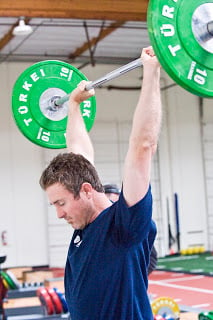
Some of the most ballistic and stressful movements in any sport occur when the body does a combination of two movements; torso rotation transmitted into an overhead arm movement. This unique coordinated action is a major source of power found in a throw in baseball or football, a serve in tennis, or a spike in volleyball. Anyone who has seen a 100 mph fastball, or a spike from an Olympic level volleyball player, can attest to the awesome power the human body can generate with this combination of movement. At SPARTA, our professional baseball players and Olympic level volleyball players are some of the most powerful athletes we see. Unfortunately, the same motions that can create such raw power, can also quickly lead to fatigue in the support muscles of the shoulder, leaving an athlete more susceptible to injury.
Traditionally, athletes shy away from overhead strengthening movements, opting instead to “play” their way into shape. But research by Gabbett indicates that skill work alone (throwing, serving etc.) whether in practice or competition, cannot adequately improve the strength of these muscles to prevent injuries.
Many athletes are concerned with the safety of performing overhead (or Olympic style) resistance exercises. But when performed correctly, and under proper supervision, these exercises are very safe. A longitudinal study by Zemper, examined four years of resistance exercise (that included overhead lifts) by college athletes, and found that the time lost from injuries related to weight training, only equaled 1% of the time those same athletes lost from injuries related to playing their actual sport.
In addition to being safe and helping to prevent injury, overhead lifts can also significantly improve performance. As we mentioned earlier, specific strength and coordination is needed to produce power overhead on the field or court. Overhead resistance exercises can more adequately prepare an athlete for sport specific skills than other, more traditional exercises. Research by Stone suggests that overhead exercises have a much greater carry-over of power in specific sport skills, than lifts such as the bench press, or squat.
At SPARTA athletes perform a variety of exercises, with special attention being paid to each athlete’s individual needs. In sports where power is transferred from the ground, through the torso and into an accelerated overhead arm motion, athletes are trained with exercises that strengthen the legs and torso, as well as stabilize important shoulder muscles.